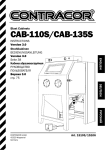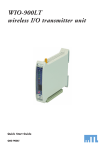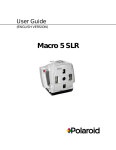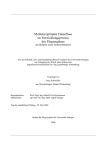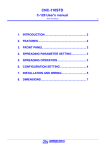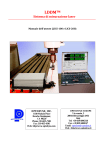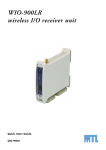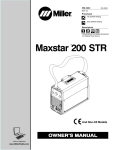Download User's Guide
Transcript
Pianox Aircraft Emissions and Performance User’s Guide Piano-X © 2008 Lissys Ltd 1 www.piano.aero Getting Started Double-click on the compressed file you downloaded. This will create a new directory called ‘Piano-X’. Inside it you will find the application itself (‘Piano-X.exe’), and two directories: One called ‘pianox-planes’, which holds all your aircraft files, and another called ‘pianox-adjustments’, in which you can save any adjustments you make. The application always expects to find these two directories at the same hierarchical level as itself. That’s all. Concept There are three menus: ‘Load’, ‘Adjust’, and ‘Output’. Use ‘Load’ first, to choose an aircraft. If you want to change anything, select an option from ‘Adjust’. You can reset the basic design weights, factor the thrust, drag, or fuel consumption, input your own emissions indices, alter the flight levels and speeds, specify reserves and allowances, or pick the units you prefer. Finally, select the ‘Output’ you are interested in and click the ‘GO’ button. The report you asked for will be shown in the text output area on the right side. Outputs can include: Summaries (or detailed step-by-step analyses) of any flight over arbitrary distances with given payloads, tabulations of block missions, instantaneous performance at any particular flight conditions, complete payload-range characteristics, and takeoff / landing field lengths. Depending on what you choose from the ‘Adjust’ and ‘Output’ menus, you will be presented with clear input options for specifying your requirements. Two buttons are available that let you save, and later reload, any adjustments you make to the aircraft. You can create and keep as many adjusted models as you want. Output reports can be saved to a text file or cleared from the screen at any time. Piano-X © 2008 Lissys Ltd 2 www.piano.aero Basic Weights Basic aircraft weights are the maximum takeoff weight (MTOW), operating empty weight (OEW), maximum zero fuel weight (MZFW) and maximum landing weight (MLW). Piano-X weights represent the best available information, and you can always adjust them to any alternative specification. Some aircraft (such as recent versions of the ubiquitous Boeing 737) are marketed in a great variety of certificated weights. Information on weight options is easy to find, though often with one significant exception: Manufacturers may be reluctant to quote a representative OEW. In fact this is the most critical weight needed in assessing performance. Specifications often provide a manufacturer’s empty weight (MEW), but this does not include operational items needed by the airline, and is not usable without an indication of the extra weight for a particular operator. The ‘standard payload’ is one for which the aircraft is nominally designed, with all seats filled, in a typical seating configuration. Maximum payload (equal to MZFW minus OEW) can be higher, corresponding to extra cargo or dense seating arrangements. The maximum fuel capacity is not a weight limit, but is required because it will normally constitute a boundary in the Payload-Range capabilities of the aircraft (together with the MZFW and the MTOW). Thrust, Drag, and Fuel Flow Engine performance in Piano-X is based on calibrated best estimates of typical installed powerplants. In cases where different engine options are available on the same airframe, the calibration will be as representative of the fleet as possible but may not explicitly identify any differences between engine types. Normally, these are small. You can use factors to adjust the maximum takeoff, climb, or cruise ratings of the engine, as well as its specific fuel consumption (SFC). Calculations of engine thrust and fuel flow depend on altitude, Mach number, and power setting; any factors you apply will shift all relevant characteristics up or down in direct proportion. Aerodynamic drag is calculated in detail (as a function of lift coefficient, Mach number, and Reynolds number) and tuned with actual lift/drag data (‘polars’) whenever these are known. You can either factor the drag uniformly using one overall value or you can adjust certain items individually. These are the zero-lift and lift-induced drag contributions, and the nominal divergence Mach number (which will influence the high-speed compressibility Piano-X © 2008 Lissys Ltd 3 www.piano.aero drag). If you change them, you should know that aerodynamic methodologies generally differ in their accounting of drag items, which may be grouped under various labels. Emission Characteristics Aviation pollutant emissions include oxides of nitrogen (NOx), hydrocarbons (HC), carbon monoxide (CO) and carbon dioxide (CO2). All except the CO2 are calculated according to standard procedures based on tested engine characteristics. The best public source for engine emissions is the ‘ICAO aircraft engine emissions databank’ maintained by the UK Civil Aviation Authority. This uses four sea-level conditions which are representative of idle, approach, climbout and takeoff. Values at arbitrary flight conditions are derived by a method based on fuel flow (‘Boeing 2’). Inputs take the form of ‘reference emissions indices’, which means simply the grams of each pollutant per kilogram of fuel burn. Carbon dioxide is not part of any databank as it is directly proportional to the fuel burn: One kg of jet fuel will produce 3.16 kg of CO2. It is only shown explicitly in the summary range reports. Piano-X models include predefined values for emissions characteristics according to either the actual engine or a nearest approximation to an actual engine. Data may not be provided for some ‘early project’ aircraft and for turboprops. If input boxes are left blank, no emissions will be calculated. Piano-X © 2008 Lissys Ltd 4 www.piano.aero Speeds and Flight Levels You can obtain mission performance data for any speeds and Flight Levels within the capability of the aircraft (FL is standard pressure-altitude in hundreds of feet). Piano-X selects optimum FLs from those listed as available. Cruise Mach can be set to a specific value, or calculated as ‘Economy’ (maximum air range), ‘Long Range’ (99% of max air range), or nominal ‘High Speed’ (max cruise rating at reference cruise). The ‘Max’ Mach option keeps max cruise rating throughout, provided only one FL is supplied (this option is used rarely, sometimes by business jets). Climb speeds are calculated (or assigned) based on a constant calibrated airspeed in knots (kcas), subject to a 250 kt limit below FL 100, and up to some Mach limit at high altitude. Descent uses a similar speed schedule in reverse. Reserves and Allowances Range calculations include sufficient fuel reserves to cover some combination of diverting over a fixed distance, holding for a set time, and retaining an amount for contingencies (as a percentage of fuel or time). In calculating block fuel, allowances are normally made for taxi-out, takeoff, approach, and taxi-in, based on time spent at a corresponding power setting for each phase. Note that individual aircraft models may use different assumptions, depending on their calibration and reflecting real-world discrepancies in reserve rules (typical International, US domestic, European shorthaul, etc). Each model can be adjusted as necessary. Piano-X © 2008 Lissys Ltd 5 www.piano.aero Unit Preferences You can choose various combinations of metric and imperial (US) units. Block Ranges and Flight Profiles Mission performance can be calculated for any required combination of range and payload within the capability of the aircraft. The nominal design range is also shown, based on the standard payload. The outputs from a ‘Block Range Summary’ include all necessary times, distances, fuel burns and pollutant emissions. This is sufficient for most practical purposes. The alternative choice of a ‘Detailed Flight Profile’ uses the same inputs but generates an exhaustive step-by-step history for the entire flight. From this it is possible to derive any spatiotemporal information and a detailed in-flight distribution of pollutants. Block Performance Tables This output option will generate tabulated block mission data for any specified combinations of range and payload. Piano-X © 2008 Lissys Ltd 6 www.piano.aero The resulting tables can be large and you may need to scroll to see specific portions. It is best to save such output in a file (using the ‘Save Output..’ button) and then examine it separately in any editor (like WordPad). If you tick the box labelled ‘Use tab separators’, the subsequent text can be copied/pasted into a spreadsheet document and will then align correctly in rows and columns. Point Performance The ‘point performance’ option generates details of instantaneous aircraft performance at a specific speed, altitude, and weight. Speed can be given in terms of Mach or kcas, ktas and keas (calibrated, true, equivalent). Outputs include various drag coefficients, lift/drag ratio, engine thrust, fuel flow and SFC, specific air range (nm/lb or km/kg) and residual performance capability as an available rate of climb. The aircraft is assumed to be in a ‘clean’ cruise configuration. Payload-Range Boundary The boundary of the Payload-Range chart is shown at the standard corner points (which correspond to MTOW with max payload, MTOW with max fuel, and zero payload cases), together with an additional list of intermediate points. Takeoff and Landing Field Lengths Takeoff and Landing field lengths are calculated according to FAR/JAR-25 rules at arbitrary combinations of weight, pressure-altitude, and temperature deviation from the International Standard Atmosphere (delta ISA). Piano-X © 2008 Lissys Ltd 7 www.piano.aero Note that (in contrast to in-flight performance predictions) takeoffs and landings are subject to variation from uncertainties regarding retardation systems, high-lift devices, differences in flying techniques, rating structures, etc. Takeoff and Landing performance should therefore be regarded as indicative only. Using Piano-X Piano-X is extremely simple to run. Nonetheless, the underlying methods are complex and various warnings may be shown if a calculation doesn’t complete. If you can’t obtain performance for a mission that you think is achievable, consider allowing lower and higher Flight Levels or changing the speed mode. For ultra-short stage lengths (say 200 nm), you may need to fix a single low level (such as FL 200). If you factor individual thrust ratings, the climb, cruise or takeoff can become impossible under different flight conditions. There may be small differences between numbers given by the ‘Block Range Summary’ and ‘Detailed Flight Profile’ outputs. The latter, more detailed method calculates portions of fuel allowances instead of using fixed time assumptions. Results will be essentially the same for typical allowances. If you produce very long reports, you may want to use the ‘Clear Output’ button at various times (preceded by ‘Save Output, if required) to flush all previous screen output. There is much more information in the User’s Guide for Piano, the complete aircraft design and performance tool, available at www.piano.aero. This online guide includes a list of terms and abbreviations applicable to all output reports produced by either Piano or Piano-X. There are also descriptions of the basic concepts and methodologies, which are common to both programs. Contact For all enquiries about Piano-X, contact Dr Dimitri Simos at: Lissys Limited 6 Paterson Drive Woodhouse Eaves LE12 8RL United Kingdom Piano-X © 2008 Lissys Ltd 8 www.piano.aero Piano-X Aircraft List* Aerospatiale AS100 Aerospatiale AS100ER Aerospatiale AS125 Aerospatiale AS125ER AI(R) 58 AI(R) 70 Airbus A3XX-50R Airbus A3XX-100 Airbus A3XX-100R Airbus A3XX-200 Airbus A300 600 light Airbus A300 600R Airbus A300 B2-200 Airbus A310-200 Airbus A310-300 Airbus A318 basic Airbus A319 basic Airbus A319 option Airbus A320-200 basic Airbus A320-200 option Airbus A321-100 Airbus A330-200 230t Airbus A330-300 230t Airbus A340-200 275t Airbus A340-300 271t Airbus A340-500 (v03) Airbus A340-500 (v05) Airbus A340-600 (v03) Airbus A340-600 (v05) Airbus A350 XWB-800 Airbus A350 XWB-900 Airbus A350 XWB-1000 Airbus A350-800 (v05) Airbus A350-900 (v05) Airbus A380-800 (v02) Airbus A380-800 (v03) Airbus Corporate Jetliner Airbus Mil A400M Antonov An-70T Antonov An-124 Ruslan Antonov An-124-210 Antonov An-148-100 Antonov An-148-200 ARJ-21 (AVIC1 v05) ATR 42 ATR 72 Avro RJ 85 basic Avro RJ 85 option Avro RJ-70 Avro RJ-100 Avro RJ-115 B707-320C B717-200 (v00) B717-200 BGW (v99) B717-200 HGW (v99) B727-200A B737-200 B737-300 (basic) B737-300 (option) B737-400 (basic) B737-400 (option) B737-500 (basic) B737-500 (option) B737-600 (NG basic) B737-600 (NG option) B737-700 (NG basic) B737-700 (NG basic)wnglt B737-700 (NG option) B737-700ER(w) Piano-X © 2008 Lissys Ltd *Sample as of March ’08. The list of available models is subject to change. B737-800 (NG basic) B737-800 (NG basic)wnglt B737-800 (NG option) B737-900 (NG option) B737-900ER(wnglt) B737-BBJ1 B737-BBJ2 B747-8 Intercontl (v06) B747-8 Intercontl (v08) B747-100 B747-200B B747-400 mfrspec B747-400 stretch (v91) B747-400ER B747-500X (dec96) B747-600X (dec96) B747-SP B747X (v01) B747X stretch (v01) B757-200 basic B757-200 option1 B757-200 option2 B757-300 B767-200 basic B767-200ER B767-300 B767-300ER B767-300ER option B767-400ER(X) B777-200 A (506) B777-200 A (515) B777-200 A (535) B777-200 B (580) B777-200 B (590) B777-200 ER (IGW) B777-200 ER (max) B777-200 LR (v04) B777-300 (632) B777-300 (660) B777-300 ER (v04) B787-3 (shrink v05) B787-3 (shrink v08) B787-8 (baseline v05) B787-8 (baseline v06) B787-8 (baseline v08) B787-9 (stretch v05) B787-9 (stretch v08) BAe 125-700 BAe 125-800 BAe 1000 BAe ATP BAe Jetstream 41 BAe NRA Beech King Air 200 Beechjet 400A Boeing 7E7 (v04) baseline Boeing 7E7 (v04) stretch Boeing Business Jet (v97) Boeing model 763-246C Boeing model 763-246CER Boeing model 763-246CS Bombardier BRJ-X-90 Bombardier BRJ-X-110 Bombardier C(v04) 110ER Bombardier C(v04) 110ST Bombardier C(v04) 135ER Bombardier C(v04) 135ST Bombardier C(v05) 110ER Bombardier C(v05) 110STD Bombardier C(v05) 130ER Bombardier C(v05) 130STD Bombardier Challenger 300 Bombardier Continental(v02) Canadair Challenger 601-3A Canadair Challenger 604 Canadair CRJ 200ER Canadair CRJ 200LR Canadair CRJ 700 Canadair CRJ 700ER Canadair CRJ 900 Canadair CRJ 900ER Canadair CRJ 900LR Canadair RJ 100 Canadair RJ 100ER Cessna Citation III Cessna Citation V Cessna CitationJet1 Cessna CitationJet2 Cessna Sovereign Cessna X Dash 8 Series 100 Dash 8 Series Q200 Dash 8 Series Q300 Dash 8 Series Q400 HGW Dassault Falcon 7X Dassault Falcon 900 C Dassault Falcon 900 EX Dassault Falcon 2000 Dassault Falcon 2000EX Dassault Falcon 9000 (v92) Dornier 328 Dornier 328JET Dornier 428JET Douglas DC 9-14 Douglas DC 9-34 Douglas DC 10-10 Douglas DC 10-30 Douglas MD-81 Douglas MD-82-88 Douglas MD-83 auxCap Douglas MD-87 Douglas MD-90-30 Douglas MD-90-50 Douglas MD-95 Tay Eclipse (v00) Eclipse 500 (v04) Embraer 170 basic Embraer 170 LR Embraer 175 basic Embraer 175 LR Embraer 190 basic Embraer 190 LR Embraer 195 basic Embraer 195 LR Embraer EMB-120 Embraer EMB-135 Embraer EMB-145 Euroflag FLA turbofan FA-X-100 FA-X-100ER FA-X-200 FA-X-200ER FA-X-300 FA-X-300ER FAAB-Mriya Fairchild Dornier 528JET Fairchild Dornier 728JET Fairchild Dornier 928JET 9 Fokker F50 Srs 100 Fokker F70 basic Fokker F70 option Fokker F100 basic Fokker F100 option Fokker F130 basic Fokker F130 option Fokker-F28 Mk4000 Global 5000 Global Express (v02) Global Express (v99) Global Express XRS (v08) Gulfstream G IV Gulfstream G IV-SP Gulfstream G V (v99) Gulfstream G V-SP Gulfstream G550 Gulfstream G650 Honda HondaJet IAI 1125 Astra IAI Galaxy G200 Ilyushin IL-62M Ilyushin IL-96-300 Ilyushin IL-96M JADC YSX75 KARI-100seater Learjet 31A Learjet 31A ER Learjet 45 Learjet 55C Learjet 60 Lockheed L-1011-200 Lockheed L-1011-500 MD-11 basic MD-11 option MD-12 HC MD-12X MD-17 Globemaster MD-XX (v91) NLA sample NSA (G1) NSA (G2) NSA (G3) NSA (G4) Raytheon Beechjet 400A Raytheon Hawker Horizon Raytheon Premier 1 Regioliner R92 Rombac 1-11 ReEng Saab 340B Saab 2000 Shorts FJX Sino Swearingen SJ30-2 Sukhoi-IL RRJ 60B Sukhoi-IL RRJ 60LR Sukhoi-IL RRJ 75B Sukhoi-IL RRJ 75LR Sukhoi-IL RRJ 95B Sukhoi-IL RRJ 95LR Superjet 100-75B Superjet 100-75LR Swearingen SJ30 original Tupolev Tu-154M Tupolev Tu-204-220 Tupolev Tu-334-100 Tupolev Tu-334-200 Tupolev Tu-334-200Str Yakovlev Yak-42M (v93) Yakovlev Yak-46PF (v93) www.piano.aero Terms and Conditions The Piano-X software and its data files are Copyright © 2008 Lissys Limited. The licencee undertakes to respect fully the confidentiality and proprietary nature of Piano-X files. Piano-X files and information derived from them may only be used by the licencee and must not be distributed or sold to other parties. Statistical results or generic analyses derived from the use of the Piano-X database but not including information on individually identifiable aircraft may be published under fair-use terms, provided full credit is given to Piano-X and provided such results are not specific to, and thereby compromise the value, marketability, or proprietary nature of, any Piano-X files. Lissys is not responsible for any damages whatsoever that might result from the use of the software, incidental or otherwise. Piano-X data must not be used in any form of operational flight planning or safety-related calculations. Information in Piano-X files constitutes the best estimate of aircraft characteristics generated by Lissys using the full Piano software and does not purport to represent guaranteed performance levels or imply the approval or involvement of any aircraft manufacturer or other organisation. Whilst Lissys endeavours to update the Piano-X database continually, it cannot warrant the frequency of any updates. Piano-X © 2008 Lissys Ltd 10 www.piano.aero











